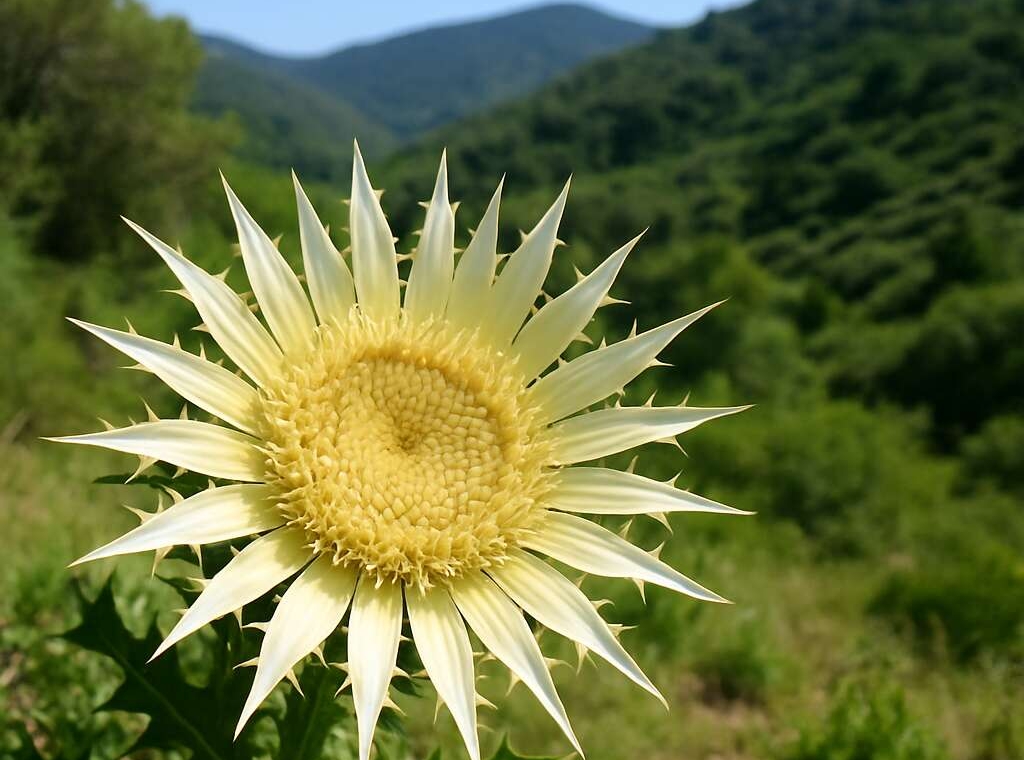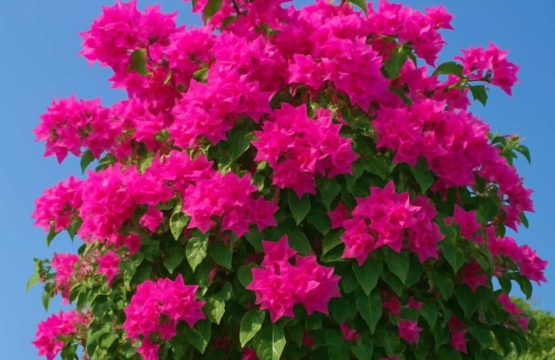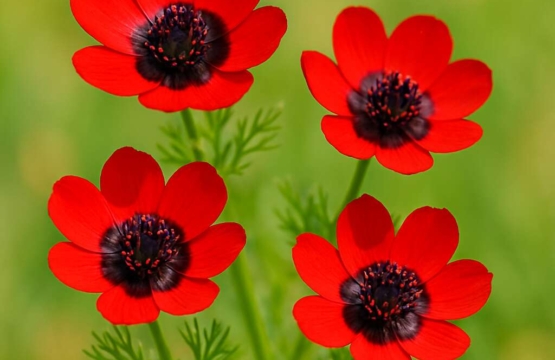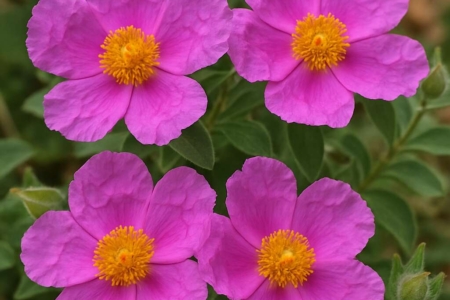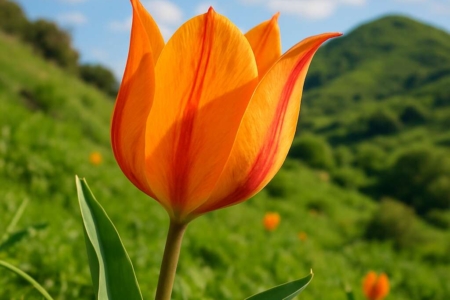Understanding Carlina pygmaea: An Endemic Species of Cyprus
Taxonomy and Classification – Details about the plant’s scientific classification and relation to other Carlina species
Amidst the rugged, sun-scorched landscapes of Cyprus, a botanical enigma quietly endures—Carlina pygmaea, known locally as the Cyprus Carline (endemic). This diminutive yet resilient plant weaves itself into the very fabric of the island’s unique flora, standing as a testament to nature’s mysterious artistry. With its solitary, spiny leaves and delicate, star-shaped flowers, Carlina pygmaea embodies a fragile elegance that captivates those lucky enough to witness it.
Taxonomically, the Cyprus Carline (endemic) belongs to the Asteraceae family, a lineage renowned for its resilience and diversity. It shares kinship with other Carlina species, yet its rarity and endemic status forge a distinct identity. Its scientific classification reveals a genus rooted in ancient evolutionary pathways, making Carlina pygmaea a living relic of Cyprus’s botanical heritage. This species’ limited distribution amplifies its significance, highlighting the delicate balance of island ecosystems and the importance of conservation efforts.
Distribution and Habitat – Specific regions within Cyprus where Carlina pygmaea is found and its preferred habitat types
Within the rugged contours of Cyprus’s untouched wilderness, the Cyprus Carline (endemic) Carlina pygmaea manifests as a delicate whisper of nature’s resilience. Its presence is confined to specific pockets of the island, turning these areas into living museums of rare botanical beauty. This endemic species predominantly inhabits the limestone slopes and rocky outcrops of the Troodos Mountains, where the sun’s relentless gaze encourages its hardy spirit.
Its preferred habitat is distinguished by well-drained, calcareous soils, which provide the perfect cradle for its solitary, spiny leaves and star-shaped flowers. These plants thrive amidst sparse vegetation, often nestled in the crevices of rocky terrain, where competition is minimal, and the environment’s austerity fosters their unique charm. The Cyprus Carline (endemic) Carlina pygmaea’s restricted distribution underscores the importance of preserving Cyprus’s fragile ecosystems, as each glimpse of this diminutive marvel offers a rare window into the island’s rich botanical heritage.
- The limestone ridges of the Troodos Mountains
- Rocky slopes with calcareous, well-drained soils
- Sparse vegetation zones that favour endemism and resilience
Physical Characteristics – Description of the plant’s morphology, size, and distinctive features
Among Cyprus’s botanical treasures, the Cyprus Carline (endemic) Carlina pygmaea stands out as a miniature marvel — a plant that, despite its modest stature, commands attention with its distinctive charm. Measuring typically no more than 15 centimetres in height, this endemic species boasts a compact, cushion-like form that fits snugly into its rocky habitat. Its spiny, grey-green leaves radiate from the centre like a well-coached chorus line, each one a testament to the plant’s resilience amidst the sun-baked limestone slopes.
The star of the show, however, is undoubtedly its striking flower head. Surrounded by a ring of bristly, straw-coloured bracts, the sunflower-like bloom emerges with a sunburst of tiny, tubular florets, often displaying hues of pale yellow and cream. This exquisite flower not only exemplifies the plant’s adaptation to its environment but also underscores the delicate beauty that endemics like the Cyprus Carline (endemic) Carlina pygmaea bring to Cyprus’s rugged landscapes.
Conservation Status – Current status, threats, and conservation measures for Carlina pygmaea
With its delicate stature and unique ecological niche, the Cyprus Carline (endemic) Carlina pygmaea is more than just a botanical curiosity—it’s a vital part of Cyprus’s natural heritage. Currently, this captivating species faces mounting threats from habitat degradation and overgrazing, which jeopardise its fragile existence. Despite its resilience, the plant’s limited distribution makes it highly vulnerable to environmental changes and human activity.
Conservation efforts are crucial to safeguard this endemic marvel. Local authorities and conservation organisations have implemented measures such as habitat preservation programmes and controlled grazing policies. These initiatives aim to minimise disturbance in key areas where Carlina pygmaea thrives and help maintain the delicate balance of its rocky, limestone-dominated habitat.
- Protecting its natural environment from development and pollution.
- Monitoring populations regularly to assess health and numbers.
- Raising awareness among local communities about the plant’s endemic significance.
While the future of Cyprus Carline (endemic) Carlina pygmaea remains uncertain, ongoing conservation measures offer hope for preserving this extraordinary species for generations to come. Its survival hinges on a shared commitment to maintaining the rugged landscapes that give it life and character.
Ecological Significance of Cyprus Carline
Role in Local Ecosystems – Interactions with pollinators, other flora, and fauna
Within the rugged landscapes of Cyprus, the endemic Cyprus Carline (Carlina pygmaea) weaves itself into the very fabric of its ecosystem, serving as a vital keystone in the delicate web of life. Its luminous, sunflower-like blooms attract a diverse array of pollinators, from buzzing bees to fluttering butterflies, each drawn by the plant’s unique nectar offerings. This interaction not only sustains the pollinators but also ensures the continued reproduction of this rare species, reinforcing the intricate balance of local biodiversity.
The Cyprus Carline (endemic) Carlina pygmaea also maintains symbiotic relationships with neighbouring flora, often thriving in harmony with hardy Mediterranean shrubs and grasses. Its presence can influence soil health, preventing erosion and enriching the mineral content through natural decay cycles. Moreover, small fauna, such as insects and ground-dwelling creatures, find shelter among its spiny leaves and robust stems, highlighting its importance beyond mere aesthetics. Such multifaceted interactions underscore the plant’s role as a cornerstone of Cyprus’s endemic flora, fostering resilience within its habitat.
Indicators of Ecosystem Health – How the presence of Carlina pygmaea signals ecological stability
The presence of Cyprus Carline (endemic) Carlina pygmaea is a compelling indicator of ecological stability within Cyprus’s fragile habitats. As a keystone species, its health reflects the overall resilience of the local ecosystem. When Carlina pygmaea thrives, it signals that the environmental conditions are favourable and that the delicate balance among flora and fauna remains intact.
This plant’s role extends beyond mere aesthetics. Its abundance often correlates with healthy soil quality and sustainable land management. Conversely, a decline in Cyprus Carline (endemic) Carlina pygmaea can serve as an early warning sign of ecological disturbance or habitat degradation. Monitoring its population provides valuable insights into the broader health of Cyprus’s native landscapes.
In fact, the status of Cyprus Carline (endemic) Carlina pygmaea is increasingly recognised as a vital bioindicator. It helps conservationists assess the impact of climate change, land use, and invasive species. Preserving this endemic plant is not just about safeguarding a single species; it’s about maintaining the integrity of Cyprus’s entire ecological network.
Endemism and Biodiversity – Importance of endemic species to Cyprus’ biodiversity and ecosystem resilience
Endemic species like Cyprus Carline (endemic) Carlina pygmaea are the genetic jewels of Cyprus’s biodiversity tapestry. These plants aren’t just pretty faces; they are vital components that bolster the resilience of the island’s fragile ecosystems. Their unique presence signifies a habitat’s evolutionary history—think of them as living proof that Cyprus’s landscape has withstood the test of time and environmental change.
In ecological terms, endemic plants such as Cyprus Carline (endemic) Carlina pygmaea serve as keystones, anchoring the health of their surroundings. They support a complex web of life, from specialised pollinators to native fauna, ensuring that biodiversity remains robust and adaptable. The survival of these species directly correlates with the stability of their habitats, making them invaluable indicators of ecosystem vitality.
Because of their specialised niches, endemic species like Cyprus Carline (endemic) Carlina pygmaea also act as natural barometers against threats such as habitat fragmentation and invasive species. Protecting these endemic plants isn’t just about preserving a single species; it’s about safeguarding the intricate ecological balance that sustains Cyprus’s natural splendour. Their presence, or lack thereof, paints a vivid picture of environmental health—highlighting the importance of biodiversity for resilience and sustainability.
Habitat Preservation Efforts – Initiatives and policies aimed at protecting endemic plants like Carlina pygmaea
The fight to preserve Cyprus Carline (endemic) Carlina pygmaea is more than just a conservation effort — it’s a battle to maintain the very soul of Cyprus’s unique landscape. With its delicate, sun-kissed blooms nestled within rugged terrains, this plant embodies the island’s evolutionary resilience. Protecting its habitat is critical, not only for the species itself but for the entire ecological web it sustains.
Numerous initiatives have been launched to shield the habitats of endemic plants like Cyprus Carline (endemic) Carlina pygmaea. These include government policies aimed at restricting land development in sensitive areas, alongside community-driven programmes focused on habitat restoration. Moreover, collaborative efforts with local conservation groups have helped identify critical zones where the plant thrives, ensuring targeted protection.
- Designation of protected areas within Cyprus known for hosting endemic species.
- Implementation of sustainable land-use policies to limit habitat fragmentation.
- Raising awareness about the ecological importance of preserving Cyprus Carline (endemic) Carlina pygmaea.
Such measures are vital because the plant’s survival hinges on maintaining its natural environment. As a keystone species, Cyprus Carline (endemic) Carlina pygmaea plays a crucial role in supporting pollinators and other native fauna. Protecting its habitat helps safeguard the intricate balance that sustains Cyprus’s biodiversity, ensuring that this rare endemic continues to flourish amidst environmental challenges.
Cultivation and Observational Insights
Growing Conditions and Care – Tips for cultivating Carlina pygmaea in botanical gardens or natural reserves
Growing Cyprus Carline (endemic) Carlina pygmaea is an exercise in patience and precision. This rare plant, confined to the rugged terrains of Cyprus, demands specific conditions to thrive beyond its natural habitat. In botanical gardens or natural reserves, mimicking its native environment is key to nurturing this endemic species successfully. The plant prefers well-drained, calcareous soils that echo the rocky slopes it calls home. Ensuring ample sunlight is crucial—Carlina pygmaea flourishes in full sun, basking in the Mediterranean warmth. Its delicate, silvery foliage and small, sunflower-like flower heads require minimal watering, making drought tolerance a vital trait for cultivation. Observational insights reveal that this plant responds dramatically to subtle shifts in soil composition and microclimate. Careful monitoring and adaptation of growing conditions can unlock its full potential, revealing the resilience hidden within this endemic treasure of Cyprus. Cultivators should pay close attention to maintaining its natural habitat parameters to preserve this unique emblem of Cyprus’ biodiversity.
Seasonal Blooming Period – Times of year when the plant flowers and best viewing practices
As the Mediterranean sun dips behind rugged Cypriot cliffs, Cyprus Carline (endemic) Carlina pygmaea begins its enchanting seasonal bloom. This delicate endemic species, a true emblem of Cyprus’s unique biodiversity, typically flowers from late spring to early summer, captivating observers with its sunflower-like heads and silvery foliage. Its brief but breathtaking blooming period offers a fleeting window of visual splendour that signals the arrival of summer’s warmth.
For optimal viewing, botanical enthusiasts and conservationists alike seek the plant during its peak in May and June. Observing Cyprus Carline (endemic) Carlina pygmaea in its natural habitat or in meticulously curated botanical gardens reveals a resilient yet subtly sensitive species. To appreciate its full splendour, it’s best to position it in well-lit, calcareous soils—mimicking its native rocky slopes—and allow the plant to bask freely in the Mediterranean sun.
- Ensure minimal disturbance, as the plant’s delicate nature demands gentle handling.
- Maintain dry, well-drained conditions—its drought tolerance is part of its resilience.
- Use observational insights to adapt microclimate variables, fostering a more vibrant display each season.
By embracing these practices, cultivators and nature lovers can witness the ephemeral yet enduring charm of Cyprus Carline (endemic) Carlina pygmaea, a botanical jewel that embodies the resilience and beauty of Cyprus’s endemic flora.
Challenges in Conservation – Issues such as habitat loss, invasive species, and climate change impacts
Despite its striking beauty, the survival of Cyprus Carline (endemic) Carlina pygmaea faces numerous challenges. Habitat loss due to urban development, agricultural expansion, and tourism infrastructure encroachment threaten its delicate rocky slopes and calcareous soils. These environments are increasingly fragmented, making it difficult for the species to sustain viable populations.
Invasive species further complicate conservation efforts. Non-native plants often outcompete Carlina pygmaea for resources, disrupting the fragile balance of its native ecosystem. Additionally, climate change has introduced unpredictable weather patterns, intensifying drought conditions and altering flowering times, which can hinder pollination cycles.
Efforts to preserve Cyprus Carline (endemic) Carlina pygmaea) include habitat protection initiatives and the creation of botanical reserves. Yet, ongoing threats demand vigilant monitoring and adaptive management strategies.
- Protection of natural habitats
- Control of invasive species
- Research on climate resilience
These measures are vital in ensuring that this endemic species continues to thrive amid environmental pressures. The resilience of Carlina pygmaea hinges on collective conservation actions that recognise its vital role within Cyprus’s unique biodiversity tapestry.
Research and Study – Recent scientific studies and findings related to Carlina pygmaea
Recent botanical research has shed new light on the fragile existence of the Cyprus Carline (endemic) Carlina pygmaea, revealing intricate details that deepen our understanding of this captivating species. Scientists have dedicated considerable effort to uncover its growth patterns, reproductive biology, and adaptive strategies in the face of environmental pressures. These studies not only affirm its status as a vital component of Cyprus’s unique biodiversity but also highlight the urgent need for targeted conservation efforts.
One particularly illuminating finding pertains to the plant’s resilience in the calcareous soils of rocky slopes, where it has evolved specialised root systems to withstand drought and nutrient scarcity. Observational insights have demonstrated that Carlina pygmaea’s flowering period peaks in late spring, coinciding with favourable pollinator activity, which is crucial for its survival. The plant’s morphology, characterised by a compact rosette of silvery leaves and striking, globe-shaped flower heads, enhances its visibility amid the rugged terrain.
Research also indicates that habitat fragmentation poses a significant threat to this endemic species, prompting conservationists to focus on habitat restoration. A noteworthy development is the use of
- seed propagation techniques in botanical gardens
- monitoring of flowering cycles
- genetic studies to assess population health
—all aimed at safeguarding Carlina pygmaea’s future. These efforts exemplify a holistic approach, integrating scientific discovery with practical conservation to preserve the delicate balance of Cyprus’s endemic flora.
Tourism and Educational Opportunities in Cyprus
Eco-tourism and Nature Tours – Guided tours highlighting endemic flora including Carlina pygmaea
Cyprus Carline (endemic) Carlina pygmaea is more than just a botanical wonder; it’s a living testament to Cyprus’s unique ecological tapestry. The island’s diverse landscapes offer a rare glimpse into the habitat of this endemic species, making it a captivating focal point for eco-tourism and nature enthusiasts alike. Guided tours that highlight endemic flora such as Carlina pygmaea provide a profound connection to the island’s natural heritage, fostering appreciation and conservation efforts.
These tours often take visitors through the rugged terrains and protected reserves where Cyprus Carline (endemic) Carlina pygmaea thrives. Participants gain insight into the plant’s role within local ecosystems and witness its resilience amidst environmental challenges. For those seeking an immersive experience, observing the seasonal blooming period of Carlina pygmaea offers a chance to witness nature’s delicate balance—an unspoken dialogue between flora and fauna that underscores the importance of habitat preservation.
Educational Programs – Workshops, seminars, and campaigns raising awareness about endemic species
Cyprus’s rich natural heritage extends beyond breathtaking landscapes to include rare endemic species like the Cyprus Carline (endemic) Carlina pygmaea. This plant embodies the delicate balance of the island’s unique ecosystems, making it an ideal focal point for educational programmes that inspire both curiosity and conservation. Educational workshops and seminars dedicated to endemic flora provide invaluable opportunities for visitors and locals alike to deepen their understanding of the island’s biodiversity.
These initiatives often feature interactive campaigns that highlight the significance of species such as Carlina pygmaea. Participants learn about the plant’s role within the local environment, fostering a sense of stewardship. Such programmes not only raise awareness about the ongoing threats to endemic species—like habitat destruction and climate change—but also encourage community involvement in preservation efforts.
Engaging with Cyprus Carline (endemic) Carlina pygmaea through these educational opportunities nurtures a profound appreciation for nature’s resilience. It also underscores the importance of protecting endemic plants to maintain the ecological integrity of Cyprus’s diverse habitats. Ultimately, these initiatives serve as a bridge connecting people to the island’s extraordinary natural beauty, ensuring its preservation for generations to come.
Photographic and Botanical Interests – Best locations and times for observing and capturing the plant
Cyprus’s rugged landscapes and sun-drenched hills are a treasure trove for nature enthusiasts, especially when seeking to capture the elusive beauty of the Cyprus Carline (endemic) Carlina pygmaea. This rare botanical marvel, with its delicate rosette of silvery, spiny leaves and striking flower heads, offers a captivating subject for photographers and botanists alike. The best times to observe and photograph Carlina pygmaea are during late spring and early summer, when its vibrant blossoms burst into full bloom, transforming the arid terrain into a tapestry of colour.
For optimal viewing, head to the rocky outcrops and open meadows within the Troodos Mountains or the Akamas Peninsula, where the endemic plant thrives in well-drained, sunlit habitats. These locations provide ideal conditions for capturing the plant’s unique morphology against a backdrop of Cyprus’s breathtaking scenery. A keen eye and patience are rewarded as the plant’s distinctive flower heads, with their intricate, spiny bracts, create compelling photographic compositions that embody the island’s wild spirit.
Whether you’re an avid photographer or a passionate botanist, witnessing the Cyprus Carline (endemic) Carlina pygmaea in its natural environment offers an immersive experience—one that deepens appreciation for Cyprus’s endemic flora and its vital role in the island’s ecological mosaic.
Supporting Conservation Through Tourism – How visitors can contribute to the preservation of endemic plants
Cyprus’s enchanting landscapes are more than just picturesque—they’re living galleries of endemic flora, with the Cyprus Carline (endemic) Carlina pygmaea standing as a botanical jewel. Visitors who venture into the island’s sun-kissed hills and rugged crags have a rare opportunity to witness this extraordinary plant. Engaging with Cyprus Carline (endemic) Carlina pygmaea not only deepens appreciation for its delicate beauty but also fosters a sense of stewardship crucial for its preservation.
Tourism can serve as a catalyst for conservation when done thoughtfully. Participating in eco-tours or guided botanical expeditions offers an immersive experience while supporting local initiatives aimed at protecting endemic species like Carlina pygmaea. Educational programmes and community-led workshops often highlight the importance of preserving Cyprus’s unique biodiversity, inspiring visitors to become advocates for the island’s endemic flora.
By choosing responsible excursions, nature lovers contribute directly to habitat preservation efforts—ensuring that future generations can marvel at the plant’s spiny, silvery leaves and pristine flower heads amid Cyprus’s wild terrains. Supporting sustainable tourism not only enriches your journey but also reinforces the vital role of endemic plants such as Cyprus Carline (endemic) Carlina pygmaea in maintaining the ecological resilience of this Mediterranean paradise.
How to Support the Preservation of Carlina pygmaea
Participation in Conservation Initiatives – Volunteer opportunities and partnerships with local NGOs
In the enchanting landscapes of Cyprus, the Cyprus Carline (endemic) Carlina pygmaea stands as a botanical marvel, a testament to nature’s resilient artistry. This rare species, confined exclusively to Cyprus’s unique terrains, beckons those who cherish the delicate balance of endemic flora. Engaging in conservation efforts not only safeguards this captivating plant but also preserves the intricate web of life it supports.
Participation in conservation initiatives offers a profound opportunity to contribute directly to the preservation of Carlina pygmaea. Volunteering with local NGOs dedicated to habitat restoration or native plant protection enables passionate individuals to help monitor populations, assist in seed collection, and restore vital habitats. These efforts are crucial, especially as habitat loss and invasive species threaten this endemic species’ survival.
Furthermore, forging partnerships with environmental organisations creates a powerful alliance for biodiversity. Collaborative projects might include seed banking, educational outreach, or eco-tourism activities that promote awareness of Cyprus Carline’s ecological significance. By engaging in these initiatives, volunteers become custodians of Cyprus’s natural heritage, ensuring that Carlina pygmaea continues to thrive amidst Cyprus’s rugged beauty.
Responsible Tourism – Guidelines for eco-friendly and ethical travel in endemic regions
In the realm of eco-conscious travel, supporting the preservation of Cyprus Carline (endemic) Carlina pygmaea isn’t just a noble endeavour — it’s an essential act of botanical heroism. Responsible tourism in these fragile habitats ensures that this tiny but mighty species continues to grace Cyprus’s rugged landscapes for generations to come. But how can travellers turn their admiration into meaningful action without turning into a botanical bulldozer?
First, it’s crucial to follow guidelines that promote eco-friendly and ethical travel in endemic regions. Respect designated paths and avoid trampling the delicate habitat where Carlina pygmaea thrives. Remember, this plant’s survival depends on careful stewardship, not off-trail exploration that can inadvertently damage its environment. When exploring, opt for guided eco-tours that prioritise conservation and provide insight into the plant’s ecological role.
To truly support the preservation of Cyprus Carline (endemic) Carlina pygmaea, consider participating in local conservation projects. Volunteering with NGOs dedicated to habitat restoration or native plant protection can be a rewarding way to contribute. These initiatives often include:
- monitoring plant populations
- seed collection efforts
- habitat restoration activities
Engaging in such activities not only aids in safeguarding this endemic species but also fosters a deeper appreciation for Cyprus’s unique biodiversity. Responsible travel isn’t just about admiring the flora from afar; it’s about becoming a conscious custodian of this natural heritage. Every step taken with care helps ensure that Cyprus Carline (endemic) Carlina pygmaea remains a testament to the island’s resilient ecological tapestry, flourishing amidst Cyprus’s wild beauty.
Spreading Awareness – Sharing knowledge through social media and educational platforms
Spreading awareness about Cyprus Carline (endemic) Carlina pygmaea is a vital step in ensuring its survival. By harnessing the power of social media and educational platforms, enthusiasts and conservationists can ignite a global conversation about this rare treasure of Cyprus’s biodiversity. Sharing captivating photographs, intriguing facts, and conservation messages helps bridge the gap between local efforts and international support.
Engaging with online communities and local educational initiatives amplifies the reach of this botanical marvel. Creating compelling content—be it blog posts, videos, or infographics—can inspire others to take an active interest in protecting Carlina pygmaea. Furthermore, participating in or organising awareness campaigns during peak blooming seasons draws attention to the plant’s ecological significance.
Consider leveraging the following strategies to bolster preservation efforts:
- Distribute informative materials highlighting the plant’s endemic status and ecological role.
- Collaborate with botanical gardens and universities to include Carlina pygmaea in educational programmes.
- Encourage local communities and tourists to participate in citizen science projects related to habitat monitoring.
Each share, each conversation, and each educational event acts as a ripple in the preservation of Cyprus Carline (endemic) Carlina pygmaea. With collective awareness, this diminutive yet resilient species can continue to flourish in Cyprus’s rugged terrains, a testament to the island’s unique natural heritage.
Advocacy for Endemic Species – Encouraging policy support and funding for endemic plant conservation
Protecting endemic species like the Cyprus Carline (endemic) Carlina pygmaea requires more than just admiration; it demands active advocacy and strategic policy support. Policymakers play a pivotal role in safeguarding Cyprus’s unique natural heritage by allocating funding and establishing conservation legislation tailored to habitat preservation. Such measures ensure the resilience of Carlina pygmaea’s fragile environments and foster sustainable coexistence with local communities.
Encouraging government and institutional backing is crucial. This can be achieved through public campaigns that highlight the ecological significance of Cyprus Carline (endemic) Carlina pygmaea. Advocacy efforts should focus on integrating endemic plant conservation into national biodiversity strategies, promoting long-term ecological stability. Formalising these initiatives often involves collaboration with botanical organisations and environmental NGOs, which can drive legislative change and secure dedicated funds.
- Lobby for increased research grants targeting endemic plant species like Carlina pygmaea.
- Support policies that restrict habitat destruction caused by development projects.
- Encourage the integration of endemic flora into protected areas and national parks.
With dedicated advocacy, the preservation of Cyprus Carline (endemic) Carlina pygmaea transitions from hope to tangible action—ensuring this botanical marvel continues to thrive amidst Cyprus’s rugged landscapes for generations to come.
